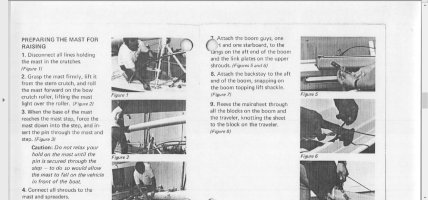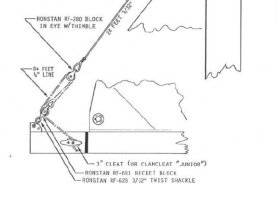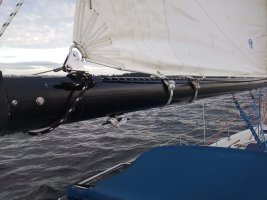I wonder if the tang at position C has a mate on the other side of the boom, and sometime in the past the boat had double preventers rigged?It seems to me that "C" is a fitting designed to hold a block.
You are using an out of date browser. It may not display this or other websites correctly.
You should upgrade or use an alternative browser.
You should upgrade or use an alternative browser.
Outhaul/Reefing help
- Thread starter Natcho
- Start date
-
- Tags
- e-27 running rigging
Then what is it for?
No idea.
If I were to guess, I might think it was for an internal outhaul tackle. There could have been a 3:1 tackle inside the boom, dead-ended inside the boom at forward end, with the working tail lead out through that sheave-box.

The thing that makes me doubt that scenario is the location of the sheave-box - it would mean you'd have to be able to reach the *aft* end of the boom in order to adjust the outhaul, which would be awkward (if not impossible - e.g., when running downwind).
The outhaul on my 32 has a 3:1 internal tackle, but the tail comes out a slot in the side of the boom just aft of the gooseneck, so it is always reachable no matter the point of sail.
I wonder if the tang at position C has a mate on the other side of the boom, and sometime in the past the boat had double preventers rigged?
Interesting idea. If the angle of the tang is intentional, it implies that the load applied to it was forward and *down*.
So maybe check you mainsail for any attached gear or line on the clew. I have seen very simple ways of attaching the clew to a shackle located at the end of the boom like you have. Maybe the PO didn't adjust the outhaul much and just tied it at a fixed tension when he sailed.
Blue Streak
E25
That might stand to reason, but the boat was never cruised. It has lived it's entire life on a 3,000 alpine lake. And the PO was not a particularly fastidious sailor. I can't imagine that a preventer ever occurred to him.I wonder if the tang at position C has a mate on the other side of the boom, and sometime in the past the boat had double preventers rigged?
Blue Streak
E25
There already is an internal outhaul with a shackle on the clew. That's part of the mystery. Why would the line enter the starboard side of the boom in such an orientation and exit below the boom, as if to lead to the step of the mast and back to the cockpit?So maybe check you mainsail for any attached gear or line on the clew. I have seen very simple ways of attaching the clew to a shackle located at the end of the boom like you have. Maybe the PO didn't adjust the outhaul much and just tied it at a fixed tension when he sailed.
Thought #2: If there is a tang on the other side, it's for the other temporary stay used when the boom was used as a 'gin pole' to lower the mast forward for trailering. If the mast base was set up as a tabernacle, that is.That might stand to reason, but the boat was never cruised. It has lived it's entire life on a 3,000 alpine lake. And the PO was not a particularly fastidious sailor. I can't imagine that a preventer ever occurred to him.
Blue Streak
E25
Brilliant!Thought #2: If there is a tang on the other side, it's for the other temporary stay used when the boom was used as a 'gin pole' to lower the mast forward for trailering. If the mast base was set up as a tabernacle, that is.
This is an E25!
And there is one on both sides!
Mr. Scarlett
Member III
Does anyone use an internal purchase for reefing? Traditional reefing(?), not single line. I want this, to be able to use one speed winches when I run lines to the cockpit.
Does anyone use an internal purchase for reefing?
There are a few problems that come to mind.
One is the space (or span) available for a purchase. On my 32-III, the first reef point is a little over 4 feet up the leech. That means I need to pull 8 feet of line in order to get that reefpoint down to the boom. My boom section (between end caps) is about 11 feet long. It'd be tough (not impossible, but tough) to get a purchase working inside the boom that allowed a 2:1 or 3:1 purchase (blocks, splices/swages, etc all add "non-working length" to a purchase).
Two, when you add a purchase you multiply the amount of line needed to make the action happen. Right now, I need only to pull 8 feet of line to get my first reef down at the clew. With a 3:1 purchase, now I'm pulling 24 feet of line for the same job. Yes, less effort, but more line
And, three.... OK, so lets say I have a purchase set up for my first reef. What do I do for my second reef? Probably not enough room inside the boom for a second purchase, and fussing with disconnecting the purchase from one reef line to connect it to another seems... inefficient. Dunno.
I have "traditional" reefing set up on my 32-III: Aft reef-line goes up from the boom, through the cringle, back down and into the boom, then down and aft along the deck to a self-tailing winch on the cabintop. Forward reef-line is a simple 2:1 tackle with a snap-shackle at the bottom end, a reefing hook at the top, and the tail led back to the cockpit where I can use either winch if needed (but generally don't need to). It's simple, it works, and there are relatively few things that can go wrong in those moments - like reefing - where you really don't want things to go wrong.
$.02
Blue Streak
E25
Ding, Ding, Ding.Thought #2: If there is a tang on the other side, it's for the other temporary stay used when the boom was used as a 'gin pole' to lower the mast forward for trailering. If the mast base was set up as a tabernacle, that is.
You are correct.
I just found it!
C is the point at which "boom guys" are attached during the mast raising process. See figure 5 below.

I have never seen any such "boom guys," but apparently that is where they connect.
Blue Streak
E25
Cam cleat for an adjustable topping lift?Now about "B"... which you can only adjust close-hauled, is for small diameter line, and the line tail would dangle?
We should be able to figure this out. Maybe. Or maybe not....
View attachment 43593

Clamcleat "junior"--new term for me, but yeah. The diagram makes sense.
For me, a clam would be unacceptable for that purpose since if it came off, the boom would fall on your headbone. Cleat is much more secure.
Even so, a topping lift should be adjustable while sailing, and at the end of the boom the line would be out of reach except to windward, and the tail would be a coil hanging. Better to run an adjustable topping lift forward to a cleat on the mast end of the boom.
Hats off to the successful detective work on this case!
For me, a clam would be unacceptable for that purpose since if it came off, the boom would fall on your headbone. Cleat is much more secure.
Even so, a topping lift should be adjustable while sailing, and at the end of the boom the line would be out of reach except to windward, and the tail would be a coil hanging. Better to run an adjustable topping lift forward to a cleat on the mast end of the boom.
Hats off to the successful detective work on this case!
Filkee
Sustaining Member
I've never been able to get this quite right, but I've just had the Eureka! moment with this explanation. I'm going to finally fix it tonight. But with winds less than ten, don't think I'll need it.The sheave at "A" is a halyard sheave box. It only works to pull a line one way--towards the gooseneck. So it won;t work for slab reefing.
To install external slab reefing, you need a cheek block there, to handle downward pull of the reef line. You can install a cleat for it on the side of the boom, near the gooseneck, or run it back to a cockpit winch. A winch is better, because it's hard to flatten a luffing sail without a purchase.
To secure the reef line to the boom (after it goes through the leech cringle), any eye strap would work as a tie-off. Ericson equipped boats with a dual purpose cheek block and tie-off, similar to this. (The ring to tie off the reef line to the boom is actually mounted upsidedown in this picture, because the line is supposed to wrap under the boom). The track is only there so the position of the cheek blocks can be adjusted for No. 1 and No. 2 reefs, which require different block placement. But all that complication not needed by boats with internal reef lines and a loose-footed main, since you can just tie a bowline around the boom for the same effect.
In Nacho's Pic No. 1 he has such a sliding cheek block on a boom similar to yours--and a cleat for it at the gooseneck end.
View attachment 43581
It's nice to have a horn, or permanent reef tack downhaul, but temporarily you could just tie the first reef tack around the gooseneck--anything to secure it before you re-tension the luff.
Your boom seems newly painted (or new?), no scratches at all. Maybe the former owner could speak to the puzzle of the hardware as installed.
I moved my topping lift aft to the boom end as well, where it terminates on a horn cleat. My topping lift gets the most use during raising/lowering the main, so the boom is mostly centered then, and the cleat accessible. To me, it beats having to make a trip up to the mast.....a topping lift should be adjustable while sailing, and at the end of the boom the line would be out if reach except to windward, and the tail would be a coil hanging. Better to run an adjustable topping lift forward to a cleat on the mast end of the boom.
I would have some "hang-ups" over a rope coil dangling from the end of a swinging boom though.
I just loop the loose end over the boom or under a reefing line. This setup doesn't preclude you from cleating the line forward (if so desired), it just gives you a longer line to deal with.

Last edited:
My topping lift gets the most use during raising/lowering the main
I guess I got lucky.... I found a "sweet spot" for my topping lift, where it keeps the boom high enough that I don't bump my head on it at the dock.... but is loose enough that it stays off the leech of the main when sailing. Couldn't tell you the last time I touched it.

